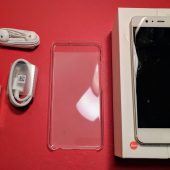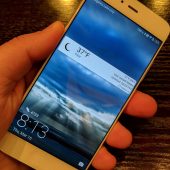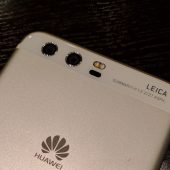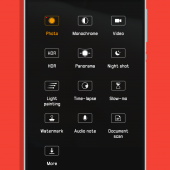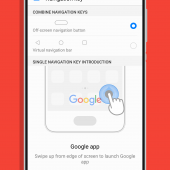I’ve always said that there is no such thing as the perfect mobile device. People have different needs and wants from a phone which is why, in part, there are so many Android devices & form factors out there today. That said, the new Huawei P10 may be close.
Really close. This 5.1″ phone is beautiful, has excellent performance, and has the latest version of Huawei’s Android build, EMUI 5.1. I don’t get smitten by phones much these days. I’ve been reviewing them for over 15 years now. But the P10… I’m smitten.
I’ve had the opportunity over the past few weeks to use the Huawei P10 as my daily driver, and it has not disappointed. It has the power to get me through the day and the performance to do anything I need it to do – from email, to streaming music and video, to playing a game of Angry Birds 2. It is a device that I have no reservation in recommending. Yes, there are some things to get used to with it, most notably the multi-function fingerprint scanner, but once you get the hang of it, you’ll really unlock this phone.
Specifications
The Huawei P10 measures 145.3 x 69.3 x 7 mm or 5.72 x 2.73 x 0.28 inches in old money. It weighs in at 145g or 5.11 ounces making it a compact, easy to hold phone. The front of the phone is dominated by the 5.1″ IPS display that renders at 1080 x 1920. That gives you Full HD quality and a pixel-per-inch count of approximately 432.
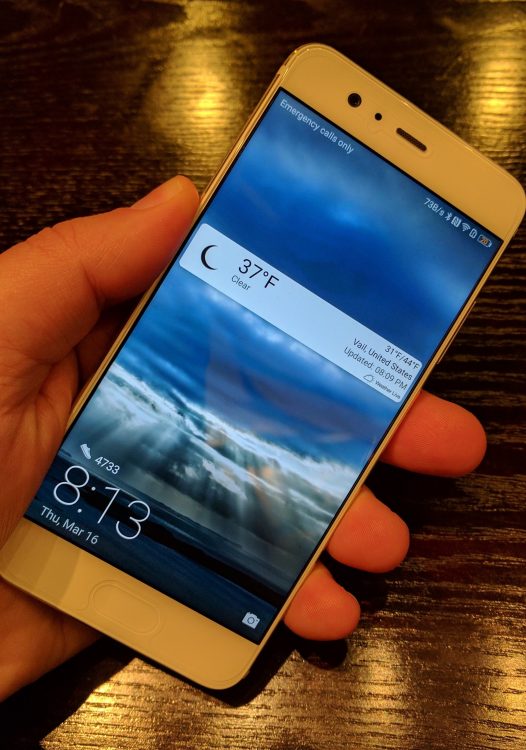
Huawei P10
That makes the P10 very easy on they eyes with vibrant colors. Protecting the display is the latest in Corning Gorilla Glass technology, Gorilla Glass 5. Below the display you will find the elongated oval fingerprint scanner. The scanner itself works great but is much more than a scanner alone. I’ll cover that bit later in the review.
Internally, the P10 is powered by the Huawei-built Kirin 960 processor. It is an octa-core design with four cores running at 2.4GHz and four running at 1.8GHz. It is coupled with the Mali-G71 MP8 GPU. If this configuration sounds familiar, it should. It is identical to the larger phablet Mate 9, a device which I reviewed a few weeks ago on ClintonFitch.com (Mitchell’s review will be on Gear Diary soon). The P10 also has 4GB of RAM which makes the phone very responsive and has either 32GB or 64GB of internal storage depending on the configuration you buy. You can expand that storage up to 256GB thanks to the MicroSD slot on the phone. Huawei uses Machine Learning to optimize the CPU and RAM as you go, learning your behaviors and optimizing applications running to impact the phone as little as possible.
On the back of the P10, you will find the dual camera configuration featuring Leica optics. The rear cameras are composed of a 12MP color shooter and a 20MP Monochrome camera. Both are f/2.2, have OIS (Optical Image Stabilization) with phased detection and laser autofocus. The camera is also capable of shooting 4K video. The front-facing selfie camera is an 8MP shooter rated at f/1.9 while shooting HD video for Instagram and Facebook Live sharing. Keep in mind that both the front and rear cameras are co-designed with Leica for a superior photo experience. I’ll cover this in more detail later in the review.
The mobile antenna array of the P10 provides a wide range of GSM 3G and 4G frequencies that will support many carriers in the world even if the phone is not being sold in a particular country. That is the case for the United States but the phone has no problem providing LTE coverage on AT&T and T-Mobile, the two networks I tested it for this review. Keep in mind that there are two variants of the P10: Single SIM (VTR-L09) and Dual SIM (VTR-L29). From a 3G perspective, the models are identical but the Dual SIM model there are some additional LTE bands supported. Here is the breakdown of frequencies and LTE bands in the P10
- HSDPA 800 / 850 / 900 / 1700(AWS) / 1900 / 2100
- LTE band 1(2100), 2(1900), 3(1800), 4(1700/2100), 5(850), 7(2600), 8(900), 9(1800), 12(700), 17(700), 18(800), 19(800), 20(800), 26(850), 28(700), 29(700), 38(2600), 39(1900), 40(2300) – VTR-L09 (Single SIM)
- LTE band 1(2100), 2(1900), 3(1800), 4(1700/2100), 5(850), 7(2600), 8(900), 9(1800), 12(700), 17(700), 18(800), 19(800), 20(800), 26(850), 28(700), 29(700), 38(2600), 39(1900), 40(2300), 41(2500) (Dual SIM)
For this review, Huawei provided the VTR-L09 single SIM model in Mystic Silver. As always, I recommend checking with your carrier before purchasing this phone to assure it will work on their network.
Connectivity is also available through the dual-band Wi-Fi antenna. It supports 802.11 a/b/g/n/ac as well as DLNA and Wi-Fi Direct. It can also serve as a hotspot for your other devices which is configured within the settings of the phone. Bluetooth 4.2 LE is on board as well for connectivity to peripherals. Lastly, there are the usual array of sensors built into the P10 such as an accelerometer, gyroscope, NFC, proximity, and compass.
Powering all of this is the built-in 3200 mAh battery. It is charged thanks to the USB-C connector at the bottom edge of the device and leverages Huawei’s SuperCharge technology for rapid charging. The technology allows for a full days charge in 30 minutes according to Huawei. In my tests, which I discuss later in the review, they are pretty much spot on with the claim.
Finally, the Huawei P10 is available in a wide range of colors and finishes. The company worked with Pantone on color options, creating six options: Mystic Silver, Rose Gold, Graphite Black, Dazzling Gold, Dazzling Blue, Greenery. Greenery is the one stirred things up when it was revealed for the first time as it is striking and certainly unique. Along with the colors, three different textures are available on the phone: Diamond-Cut, Sandblast, and High Gloss. Not all colors are available in all textures.
Form Factor
The Huawei P10 is comfortable to hold and easy to operate with one hand. The 5.1″ display sits in a chassis that is just over 5.7″ in height so you have a nice screen-to-body ratio of 71%. The front of the phone is dominated by that Full HD display which is nearly bezel-less on each side. Above the display is where find the front facing camera, proximity sensor and speaker while below the display is where you find the fingerprint scanner. Turning the phone over, you will find the aluminum back of the phone with the dual cameras in the panel at the top. These cameras are accompanied by the dual-tone flash and the auto-focus arrays. The phone looks fit-and-finished with all the makings of a high-end phone.
Last year on the P9, Huawei kept the fingerprints scanner in what has become the traditional position on Android phones: The middle of the back. It makes sense as it is easy to reach with any finger while you hold the phone. This year they moved it to the front, just below the display. It is shaped much like a lozenge and if you are coming from an iPhone, this is going to remind you a lot of the Home button. But on the P10, this is more than a scanner and home button. It is actually multifunctional and designed to replace the on-screen navigation buttons. I’m going to cover this later in the review but I will say it does take some getting use too. Once you do, however, it is a lovely way to move around the phone.
The top edge of the phone is smooth with the edge corners gently rounded, much more so than the P9 from last year. This makes the phone a bit more comfortable to hold. On the bottom, you will find the 3.5mm headphone jack and the speaker flanking the USB-C connector in the middle for charging. Despite only having the one speaker, the sound quality out of the P10 is good enough for music and conference calls.
When I first unboxed the Huawei P10, it immediately struck me as a phone you wanted to touch. The corners of the phone are comfortably curved and the all aluminum chassis feels firm and solid in your hand. It has that thing I like to call “caressability”. You want to touch this phone and you don’t really want to put it down. Looking at it, the P10 certainly has some of the markings of the iPhone 6. I don’t think you can overlook that fact but equally, it shouldn’t be a distraction.
Multifunction Fingerprint Scanner
While the internal improvements between the P9 of last year and this year’s P10 are noteworthy, perhaps the most noticeable change between the two devices is the moving of the fingerprint scanner from the back to the front of the phone. If you looked at the P10 and compared it to an iPhone, it looks like a Home button. And it is – but it is more. Huawei designed the scanner to be multifunction and in effect replace the on-screen buttons that every Android phone has on it. With this button, you can tap to go back, either to your Home screen or, in Chrome, to the previous web page. If you long press it, you will go back to the Home screen. This motion will likely feel the most natural at first. Finally, if you swipe either left or right, you will be brought to your Recents page with your running apps. Sound familiar? It should because these replicate the on-screen buttons. In fact, you can configure the P10 to eliminate the on-screen buttons if you want. Or you can leave them there and have the button simply be there to scan your fingerprint to unlock your phone. It is entirely up to you.
But if you decide to pick up the Huawei P10, based on this review or others, I strongly encourage you to give it a go. Once you get the hang of it, it is a fast and elegant way to move around the phone. Also, I fully admit that I was skeptical, mostly because of the placement of the button itself. Back in March, Judie and I sat at my dining table here in Vail, Colorado and we both were skeptical. We both felt it would be too confusing as it looked and somewhat felt like an iPhone Home button. But having lived with this phone as my daily driver for a few weeks now, I am happy to admit I’m wrong. This button is powerful and useful, far more than a simple fingerprint scanner.
By default, the scanner button is going to have the multifunction capabilities disabled. If you want to change that, you can do so within the settings of the phone.
Overall Performance
Let me drop the mic now. The Kirin 960 processor may well be the best silicon in the market today. This octa-core processor is fast, amazingly so. You combine that with a solid GPU, 4GB of RAM and Machine Learning that is learning how I use the phone, you end up with what I would contend is the fastest phone out there. Using the Benchmark OS II app to test the phone, it scored a stunning 3393. That is the fastest phone I’ve ever tested and according to the testing done at GSMArena, makes it the fastest phone they have ever tested. It outpaced the Google Pixel XL by some 492 points in their tests. In my testing, it crushed my Nexus 6P by over 2000 points. I’ve never really had a complaint about the speed of my 6P but spend any amount of time with the P10 and all other phones pale in comparison when it comes to speed. Yes, it is that noticeable.
Benchmarks aside, using the P10 in normal, day-to-day scenarios proved to be a fast and fun experience. Like all phones I review, I ran it through a set lineup of apps: Gmail, YouTube, Chrome, Real Racing 3, and Angry Birds 2. In each of these activities, the phone was responsive and agile. I never experienced any lag or hesitation in any of the activities, especially in gaming where this counts most. While the 5.1″ screen isn’t exactly conducive for long periods of gaming, playing graphically intense games like Real Racing 3 was no problem. It kept up with all of the graphics wizardry fully engaged. Likewise, streaming video was not an issue on YouTube or Netflix in my testing. I tested this both on Wi-Fi and on 4G (via T-Mobile) and was able to stream HD content without any lag, pixelization or stuttering of the video stream.
Camera Performance
My temptation for this part of the review is to simply post a photo from the P10 and let you judge. But that wouldn’t be very informative on the whole because it doesn’t tell the entire story.

P10 Outdoor Photo
First, the photo quality from this phone is amazing. Color accuracy is stunningly good and it does well in outdoor and indoor shooting. Flash photos are equally solid with the P10, not washing out or looking too “cool”. The dual-tone flash does a great job. The photos are rich in color, contrast, and depth. I found shooting with the P10 in all situations proved to be no problem for it.
Second, and perhaps equally as important, is the camera app itself. Huawei has done a fantastic job with the camera app in this phone, which is the same as the one in the larger Mate 9. It has loads of options and settings for any shooting situation. Accessing these different modes is done by swiping to the right in the app then selecting the type of photo you are going to shoot. I tried out several of these and all do add a bit of flare or improvement to your photos depending on the scene. For example, if you use the front facing camera, automatically it will put the camera into portrait mode. This gives a wide-angle effect so your face is clear but the background is blurry. It adds a dramatic effect to your photos. I encourage you to play with these different modes and give them a try after you get the basics down. The bottom line here is that the camera and the app for it perform exceptionally well together.
Display Performance
With ~432 PPI, the display on the P10 is excellent. Color accuracy and depth is great and viewing the display for long periods of time, even at 5.1″ in size, is not a problem. That solid PPI count makes text clear to read, be it an eBook in the Google Play Books or the Amazon Kindle app. Huawei has built a lot of technology into the display such as a warming mode that makes it easier on the eyes when reading in low light. You can schedule this feature to start automatically so if you are a bedtime reader like me, that elimination of the blue light in the display makes reading longer easier.
Add to this the excellent touchscreen technology Huawei has built into the phone. Touches quick, responsive and more importantly, accurate. One of the challenges that some users find, especially those of us who have larger hands, is that typing on a 5.1″ display makes things cramped which, in turn, makes typing accuracy go down. I haven’t found this to be the case on the P10. Huawei has done built an excellent touchscreen matrix on the display which makes this accuracy possible.
The Mali-G71 GPU in the Huawei P10 is plenty fast for keeping up with games and other high drawing apps. In play games like Real Racing 3 or F1 2016, games which have high frame rates and draw speed needs, the phone had no problem keeping up. I noticed no artifacts or heavy pixelization as I played these games. On less intensive games like Angry Birds 2, I’m not sure that the P10 was even really taxed by them. If you want to play games on the P10, it can keep up with you with no problem from all perspectives, including the display.
Audio Performance
When I first received the Huawei P10, I was skeptical of how the audio performance would be from the phone. I suspected that using the 3.5mm jack or even Bluetooth it would sound great given the phone supports 24-bit audio. What I didn’t expect was that given the phone has one primary speaker for audio to sound good out of that speaker. I’m glad to be wrong. For sure, the audio out of the headphone jack provides a superior experience but there is nothing to frown upon with regards to the speaker audio. Listening to music or a conference call through the speaker is a distortion-free experience with plenty of amplitude for listening even in a conference room.
Don’t expect the speaker audio performance of the P10 to set the world alight. It’s good, but not great. With headphones, however, it is a different matter as the audio experience is excellent.
Battery Performance
Another big bright spot for the P10 is the battery life. It is outstanding. It is easy to get through an entire day through normal usage and even with heavy usage, can make it a long way through your day. The 3400mAh battery was easily able to make it through a typical day of email, music streaming, YouTube viewing and conference calls. Even on days where I utilized heavy GPS tracking while skiing, the battery was able to last a solid 6 hours with 4 hours of this type of use.
While the technology of the battery itself is nothing particularly special, the management of power in the Huawei P10 is special. Huawei has built in aggressive but powerful (and user-friendly) battery saving software into the phone. It is constantly reviewing apps in use and providing notifications on apps that are using an excessive amount of power. You can configure the phone where these heavy battery apps get killed off automatically if you want to do so. Further, Huawei builds in two battery saving modes that all-but shut down notifications and data access to really stretch the battery out, upwards 100 hours of battery life.
EMUI 5.1
With the Mate 8 last year, one of my biggest complaints about the device was EMUI 4.0. The then Android Marshmallow based UI that Huawei built for the phone was clunky at best
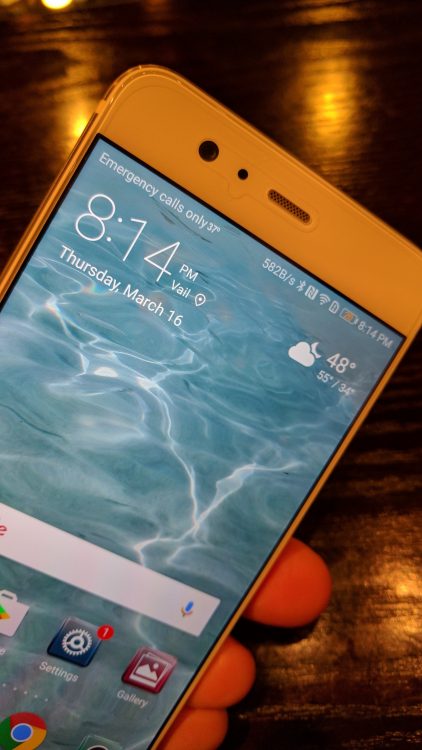
EMUI 5.1 on the Huawei P10
and simply unworkable at worst. I had no issue with the hardware but it was overshadowed by the UI. Thankfully Huawei addressed this with the Mate 9. The phone ships with EMUI 5.0 which is based on Android Nougat 7.0. Seemingly, everything that they got wrong with 4.0 they fixed and them some in 5.0. Now the user experience matches the powerful of the phone.
For the most part, EMUI 5.0 was a complete revamp and comparing it to stock Android Nougat, you won’t find a massive amount of contrast. EMUI 5.1 has taken that further with improved machine learning and other refinements but it still runs Nougat 7.0. Yes, Huawei skinned everything and made modifications to the notification panel but all the changes make sense. Things are no longer buried in the Settings. Add to that the significant boost in performance that 5.1 has over 4.0 and you have a much more pleasant and dare I say fun experience.
A key element of EMUI 5.1 is the integrated Machine Learning from Huawei. In effect, this allows the P10 to learn your behaviors on how you use the phone. It monitors how you move around the phone, the apps that you use and other things to optimize the experience. This optimization includes optimizing the CPU and RAM to give you the best user experience possible. As you use the phone more, it learns more and it speeds up as it anticipates what you will be doing next with it. It sounds like a great promise and is an excellent application of ML in the real world.
Like its predecessor, and as I mentioned earlier in the review, this build of EMUI is pretty aggressive when it comes to battery saving features. Most of these you will be able to adjust to your liking to improve performance.
All this said, there is no requirement that you stick with the launcher elements of EMUI. You can change to another launcher that meets your needs, like Nova Launcher or the Google Now Launcher (while it is still available) if those are more to your liking.
Conclusion & Recommendation
I will conclude this review the same way that I started it: I’m smitten by the Huawei P10. It is a powerful, fast and frankly beautiful phone with an incredible camera with Leica optics. There really isn’t anything not to like about it other than maybe wanting a slightly better speaker in it. But for a daily driver that can handle your day-to-day as well as a bit of fun, this phone certainly is up to the task.
The Huawei P10 retails for $685, and it is available overseas. It is currently not available in the United States (expected to be here soon, however).
Source: Manufacturer supplied review sample
What I Like: CPU/RAM performance, Camera performance, Battery Life
What Needs Improvement: Better speaker
- Huawei P10 Unboxed
- Huawei P10
- EMUI 5.1 on the Huawei P10
- Cameras of the Huawei P10
- Camera Settings on the Huawei P10
- Navigation Button Configuration
- P10 Outdoor Photo
- P10 Outdoor Photo

